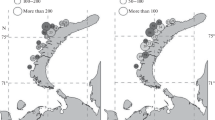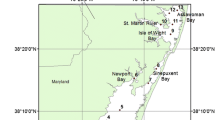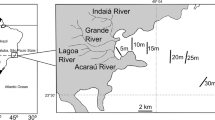Summary
10 species of Mysidacea were sampled during the Polarstern and Walther Herwig SIBEX cruises to the Antarctic Peninsula region from 1983 to 1986. The commonest were Antarctomysis maxima, A. ohlini and Mysidetes posthon. For these species the size and maturity stage composition as well as the length-weight relationships are given. The species considered are growing slowly and attain a long life span, M. posthon reached age class 3+, A. ohlini at least lived as long as 5 years, while A. maxima was found to be of age 5+ in the Peninsula area and probably 6+ in the Weddell Sea. The generation time of Antarctomysis species was 4 years and 3 years in Mysidetes posthon. Fecundity was low, mean number of offspring was about 13 for M. posthon and 21 for A. maxima. Rematuration was observed for the species A. maxima, indicating several spawning events during its life span. Biomass production is low for A. maxima, shown by a P/B-index of 0.98. Mortality of this species was estimated to be Z=1.1, which indicates that 33% of the specimens of an age group survive until the next year. The distribution and spatial separation of the two Antarctomysis species is discussed.
Similar content being viewed by others
References
Andriashev AP (1977) Some additions to schemes of the vertical zonation of marine bottom fauna. In: Llano GA (ed) Proc 3rd SCAR Symp Antarct Biol, Washington, pp 351–360
Baker A de C, Clarke MR, Harris MJ (1973) The N.I.O. Combination Net (RMT 1+8) and further developments of rectangular midwater trawls. J Mar Biol Assoc UK 53:167–184
Beverton RJH, Holt SJ (1957) On the dynamics of exploited fish populations. Fish Invest London, Ser II 19:1–533
Birstein YA, Chindonova YG (1962) Mysidacea collected by the Soviet Antarctic Expedition on the M/V ‘Ob’. Biol Rep Sov Antarct Exp (1955–1958) 1:57–67
Childress JJ, Price MH (1978) Growth rate of the bathypelagic crustacean Gnathophausia ingens (Mysidacea: Lophogastridae). 1. Dimensional growth and population structure. Mar Biol 50:47–62
Denys CJ, McWhinnie MA (1982) Fecundity and ovarian cycles of the Antarctic krill Euphausia superba (Crustacea, Euphausiacea). Can J Zool 60:2414–2423
Fütterer D (1984) Die Expedition ANTARKTIS II mit FS “Polarstern” 1983/84. Ber Polarforsch 18:1–92
Hempel G (1985) Die Expedition ANTARKTIS III mit FS “Polarstern” 1984/85. Ber Polarforsch 25:1–209
Holme NA (1964) Methods of sampling the benthos. Adv Mar Biol 2:171–260
Holt EW, Tattersall WM (1906) Preliminary notice of the Schizopoda, collected by H.M.S. ‘Discovery’. Ann Mag Nat Hist 17:1–11
Macdonald PDM, Pitcher TJ (1979) Age groups from size-frequency data: A versatile and efficient method of analyzing distribution mixtures. J Fish Res Board Can 36:987–1001
Makarov RR (1975) A study of the second maturation of female Euphausia superba (Eucarida, Euphausiacea) (in Russian). Zool Zh 54:670–681
Mauchline J (1980) The biology of mysids and euphausiids. Adv Mar Biol 18:1–369
Mauchline J, Murano M (1977) World list of the Mysidacea, Crustacea. J Tokyo Univ Fish 64:39–88
Pommeranz T, Herrmann C, Kühn A (1982) Mouth angle of the Rectangular Midwater Trawl (RMT 1+8) during paying out and hauling. Meeresforschung 29:267–274
Rustad D (1930) Mysidacea. Sci Res Nor Antarct Exp 1927–1928 and 1928–1929. 6:1–28
Sahrhage D (1986) Participation of the Federal Republic of Germany in SIBEX and CCAMLR activities on the Antarctic marine living resources. Arch Fischereiwiss 37:3–24
Siegel V (1985) On the fecundity of Antarctic krill, Euphausia superba (Euphausiacea). Arch Fischereiwiss 36:185–193
Siegel V (1986) Investigations on the biology of the Antarctic krill, Euphausia superba, in the Bransfield Strait and adjacent areas (in German). Mitt Inst Seefisch Hamburg 38:1–244
Tattersall OS (1955) Mysidacea. Discovery Rep 28:1–190
Tattersall OS (1961) Report on some Mysidacea from the deeper waters of the Ross Sea. Proc Zool Soc London 137:553–571
Tattersall OS (1965) The fauna of the Ross Sea. Part 4. Mysidacea. Bull NZ Dep Sci Indust Res 167:1–35
Ward P (1984) Aspects of the biology of Antarctomysis maxima (Crustacea: Mysidacea). Polar Biol 3:85–92
Ward P (1985) On the biology of Antarctomysis ohlini (Crustacea: Mysidacea) at South Georgia. Br. Antarct Surv Bull 67:13–23
Winberg GG (1971) Methods for the estimation of production of aquatic animals. Academic Press, London, 175 pp
Zimmer C (1914) Die Schizopoden der Deutschen Südpolar-Expedition 1901–1903. Dtsch Südpol Exp 15 Zool 7:379–409
Author information
Authors and Affiliations
Rights and permissions
About this article
Cite this article
Siegel, V., Mühlenhardt-Siegel, U. On the occurrence and biology of some Antarctic Mysidacea (Crustacea). Polar Biol 8, 181–190 (1988). https://doi.org/10.1007/BF00443451
Received:
Accepted:
Issue Date:
DOI: https://doi.org/10.1007/BF00443451




